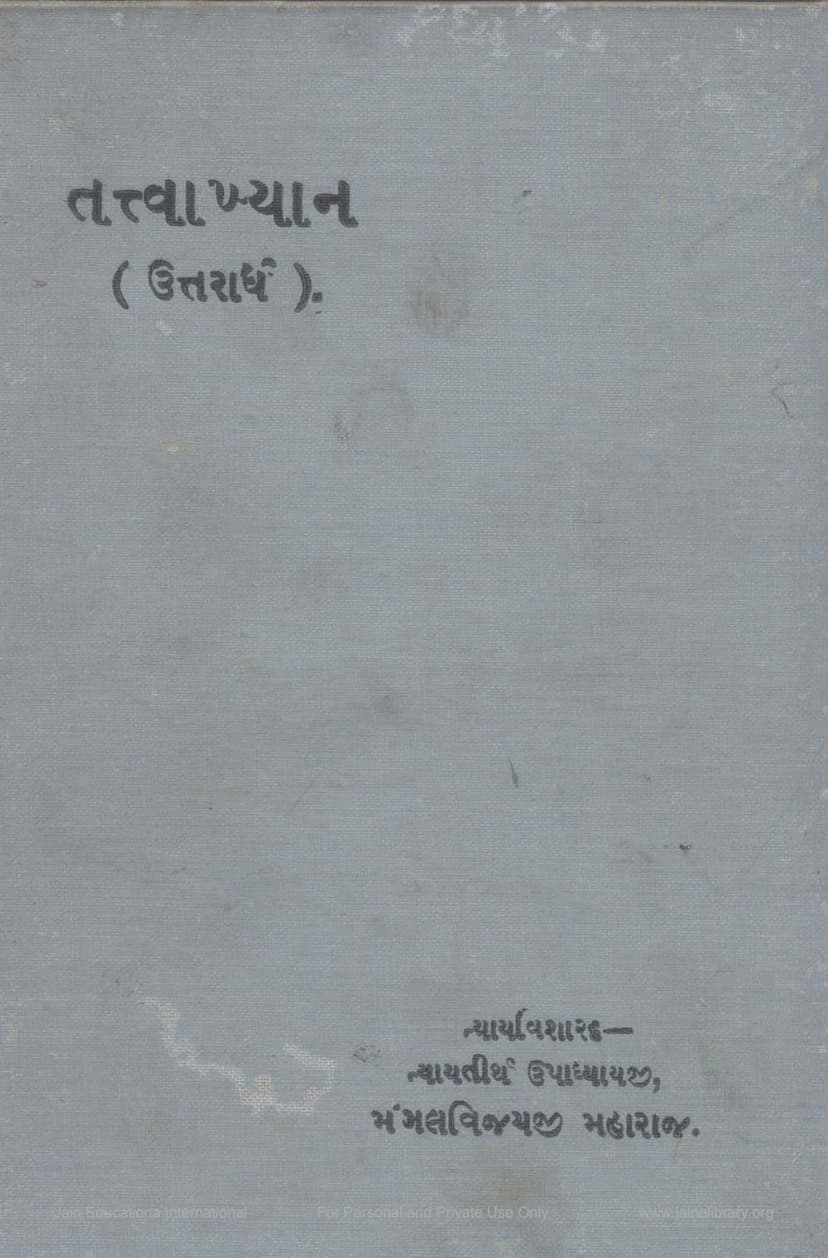Tattvakhyan Uttararddha
Added to library: September 2, 2025

Summary
The book "Tattvakhyan Uttararddha" (Philosophical Exposition, Part Two) by Upadhyay Mangalvijayji Maharaj, published by Yashovijay Jain Granthmala, Bhavnagar, is a significant work in Jain philosophy and comparative study of Indian religions. This summary is based on the provided Gujarati text.
Overall Context:
- Author: Upadhyay Mangalvijayji Maharaj, a scholar honored with the titles of Nyayatirtha and Nyayavisharad.
- Publisher: Yashovijay Jain Granthmala, Bhavnagar.
- Catalog Link: https://jainqq.org/explore/005320/1
- Purpose: To present and analyze the philosophical tenets of various Indian schools of thought, with a particular focus on Jainism, offering a balanced and scholarly critique.
- Structure: The book is divided into sections (Prastavs) covering different philosophical systems. The "Uttararddha" (Part Two) specifically covers Mimamsaka and Jain Darshana (philosophy).
Key Content and Themes:
- Comparative Philosophy: The book aims to present and critically analyze the core principles of various Indian philosophical schools, including Sankhya, Bauddha (Buddhism), Nyayika, Vaisheshika, Mimamsaka, and Jainism. The author's approach is characterized by fairness, impartiality, and a commitment to logical reasoning, as highlighted in the introduction.
- Jainism's Inclusivity and Openness: A major theme discussed, particularly in the introduction and later sections, is the inherent inclusivity and broad-mindedness of Jainism. This is contrasted with other traditions, emphasizing Jainism's lack of exclusion based on caste or gender in its spiritual teachings. The concept of "Jina" (one who has conquered inner enemies like passion and hatred) is presented as universal, not limited to a specific individual.
- Critique of Other Philosophies (with Fairness): The author engages with the philosophies of Sankhya, Buddhism, Nyaya, Vaisheshika, and Mimamsa. While presenting their views, there's a clear effort to analyze them from a Jain perspective, often highlighting areas where other systems might fall short or deviate from what the author presents as the ultimate truth. The critique is generally presented with a neutral and analytical style, upholding Jain principles of non-violence and non-absolutism (Syadvada).
- Emphasis on Syadvada and Anekantavada: The Jain principle of Syadvada (the doctrine of manifold aspects or conditional predication) and Anekantavada (the doctrine of non-absolutism or manifoldness of reality) are presented as foundational to Jain philosophy. The introduction highlights how these principles foster a balanced and comprehensive understanding of reality, acknowledging that each perspective contains a partial truth.
- Key Jain Concepts Discussed:
- Pramana: The sources of valid knowledge in Jainism are discussed.
- Aatma (Soul): The nature of the soul, its bondage, liberation, and its relationship with the body are explored.
- Mukti (Liberation): The path to liberation, primarily through Right Faith (Samyak Darshan), Right Knowledge (Samyak Jnana), and Right Conduct (Samyak Charitra), is emphasized.
- Deva, Guru, Dharma: The Jain definitions and characteristics of these three jewels of Jainism are elaborated upon.
- Ethical and Ritualistic Aspects: The book delves into the code of conduct for householders (Shravakas) and ascetics (Sadhus/Munis), outlining their respective practices and vows. This includes discussions on purity, daily routines, and the importance of adherence to scriptural guidelines.
- The Nature of Reality: The text engages with concepts like the nature of reality, the self, the causes of suffering and liberation, and the means to achieve it, often contrasting these with other philosophical viewpoints.
- Scholarly Approach: The introduction by H. B. Bhide and the endorsements by other scholars suggest a high regard for Muni Mangalvijayji's scholarship. The text is noted for its clear and simple language, making complex philosophical ideas accessible. The author's extensive study of various texts, including those from other traditions, is evident.
- Dedication: The book is dedicated to the author's spiritual guru, Acharya Shri Vijaydharmsuri Maharaj, acknowledging his immense grace and guidance.
Summary of Key Sections:
- Introduction (Prastavana): Sets the stage for the book, highlighting the author's dedication and the importance of comparative philosophy. It acknowledges the challenge of writing such a comprehensive work and expresses humility while acknowledging the support of his guru.
- Mimamsaka Darshana: This section details the principles of the Mimamsaka school, including its two main branches (Purva and Uttara Mimamsa), their practices, beliefs about Brahman, the concept of rituals (Yajna), the types of ascetics, concepts of purity, tapas, and the various means of valid knowledge (Pramanas) recognized by them. The author also offers a critique of these points from a Jain perspective.
- Vedanta Mimamsa: This part delves into the core tenets of Vedanta, particularly Advaita Vedanta, discussing the nature of Brahman, the soul's identity with Brahman, the concept of Maya, the four stages of life (Ashramas), and the means of achieving liberation. The author also provides a critique of these ideas.
- Jain Darshana: This extensive section focuses on Jain philosophy, covering:
- Aachar (Conduct): Distinguishing between the conduct of householders (Shravakas) and ascetics (Sadhus), with a detailed explanation of the vows (Anuvratas and Mahavratas) and ethical principles.
- Dravyas (Substances): Explaining the fundamental categories of reality in Jainism.
- Pramanas (Means of Knowledge): Detailing the Jain epistemological framework.
- Ishvara (God): Presenting the Jain view on the concept of God, contrasting it with other traditions.
- Syadvada: Elaborating on the core Jain principle of conditional predication and its significance.
- Karma and Liberation: Discussing the principles of karma, its bondage, and the path to liberation.
- Concluding Remarks: The author expresses hope that the book will be well-received and contribute to a better understanding of Jain philosophy and its place within the broader Indian intellectual tradition.
Overall Significance:
"Tattvakhyan Uttararddha" is presented as a comprehensive effort to explain and analyze various philosophical systems, ultimately showcasing the depth, logic, and inclusiveness of Jain philosophy. The author's approach, blending presentation with critical analysis, makes it a valuable resource for students and scholars of Indian religions and philosophies. The emphasis on clarity and accessibility in language makes it suitable for a wider audience interested in spiritual and philosophical inquiry.